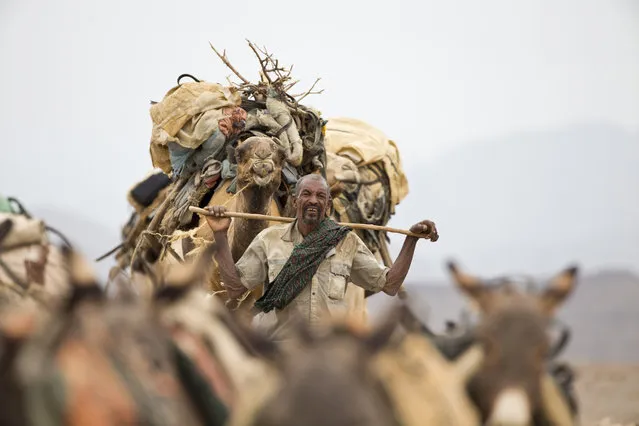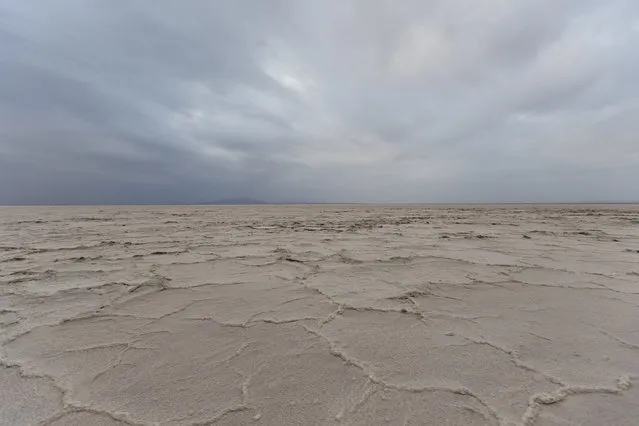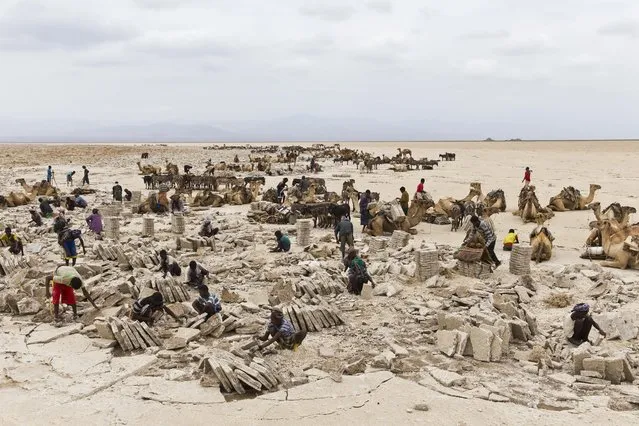Inside the Afar Triangle in Ethiopia’s Danakil desert, camel caravans are used to carry salt. For centuries, the essential mineral has been mined by the Afar people, known for their ability to withstand extremes. The terrain is rugged, travelers are scarce and so are motor vehicles, where the average annual temperature is the highest in the world, and can rise to 122 degrees Fahrenheit, 50 degrees Celsius. The Afar still cut the salt by hand, loading it onto camel caravans for the two-day journey to Berahile. The slabs are then transported from there by truck to all parts of Ethiopia for sale as table salt and for use in animal feed. The salt trade, from the pans to the camels to the trucks, fuels the entire economy for the area.
Mining is done on ground up to two kilometers deep of pure salt. Workers operate in stages: Peeling the salt from the soil by sticking long thin tree trunks beneath the shell; detaching a large salt-board from the layer underneath; then breaking the salt-board into smaller ones with an axe. Gentle chiseling removes top and bottom thin layers, exposing clean salt. A final chisel slips the lateral faces for a more uniform look. About 2,000 camels and 1,000 donkeys make the trip daily from Berahile to the quarry. Each camel can carry up to 300 pounds of salt that sells for about US $10.
Mining is done on ground up to two kilometers deep of pure salt. Workers operate in stages: Peeling the salt from the soil by sticking long thin tree trunks beneath the shell; detaching a large salt-board from the layer underneath; then breaking the salt-board into smaller ones with an axe. Gentle chiseling removes top and bottom thin layers, exposing clean salt. A final chisel slips the lateral faces for a more uniform look. About 2,000 camels and 1,000 donkeys make the trip daily from Berahile to the quarry. Each camel can carry up to 300 pounds of salt that sells for about US $10.

February 8, 2014 – Danakil Desert, Ethiopia: Workers mining salt at the quarry. (Photo by Ziv Koren/Polaris)

February 7, 2014 – Danakil Desert, Ethiopia: Camel caravan. (Photo by Ziv Koren/Polaris)

February 8, 2014 – Danakil Desert, Ethiopia: Camel caravans are used for carrying salt through the Danakil desert in the Afar Triangle. (Photo by Ziv Koren/Polaris)

February 7, 2014 – Danakil Desert, Ethiopia: Camel caravans are used for carrying salt through the Danakil desert in the Afar Triangle. (Photo by Ziv Koren/Polaris)

February 7, 2014 – Danakil Desert, Ethiopia: Camel caravan. (Photo by Ziv Koren/Polaris)

February 8, 2014 – Danakil Desert, Ethiopia: Workers mining salt at the quarry. (Photo by Ziv Koren/Polaris)

February 8, 2014 – Danakil Desert, Ethiopia. (Photo by Ziv Koren/Polaris)

February 7, 2014 – Danakil Desert, Ethiopia: Salt merchants rest for the night in a canyon during their journey to and from the Danakil Depression. (Photo by Ziv Koren/Polaris)

February 7, 2014 – Danakil Desert, Ethiopia: Salt merchants rest for the night in a canyon during their journey to and from the Danakil Depression. (Photo by Ziv Koren/Polaris)

February 8, 2014 – Danakil Desert, Ethiopia: Camel caravans are used for carrying salt through the Danakil desert in the Afar Triangle. (Photo by Ziv Koren/Polaris)

February 8, 2014 – Danakil Desert, Ethiopia: Workers mining salt at the quarry. (Photo by Ziv Koren/Polaris)

February 8, 2014 – Danakil Desert, Ethiopia: Camel caravans are used for carrying salt through the Danakil desert in the Afar Triangle. (Photo by Ziv Koren/Polaris)

February 8, 2014 – Danakil Desert, Ethiopia: Workers mining salt at the quarry. (Photo by Ziv Koren/Polaris)

February 7, 2014 – Danakil Desert, Ethiopia: An isolated village on the road of the camel caravans used for carrying salt through the Danakil desert in the Afar Triangle. (Photo by Ziv Koren/Polaris)

February 6, 2014 – Berahile, Danakil Desert, Ethiopia: Unloading salt slabs in Berahile. (Photo by Ziv Koren/Polaris)
30 Apr 2014 08:17:00,
post received
0 comments
